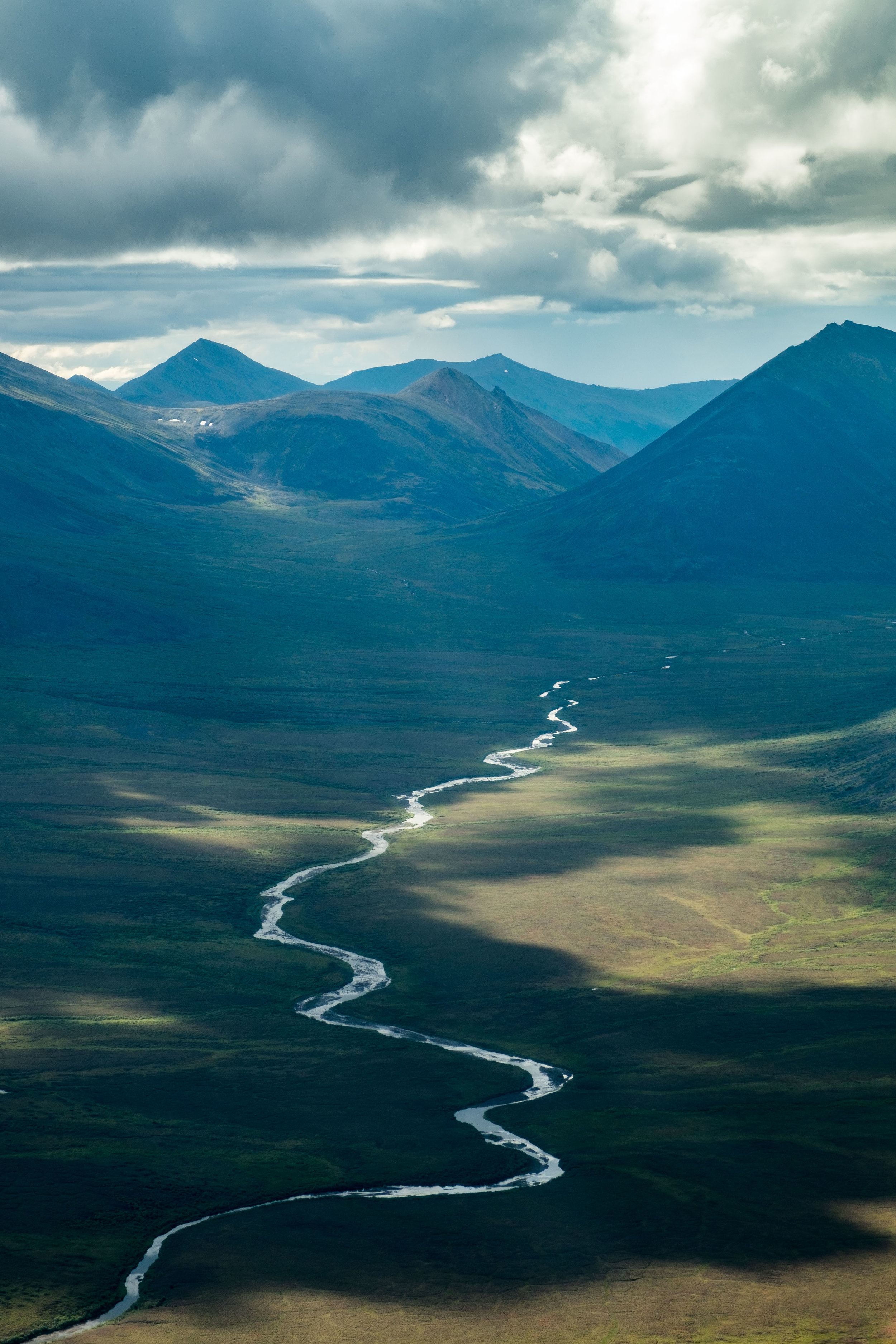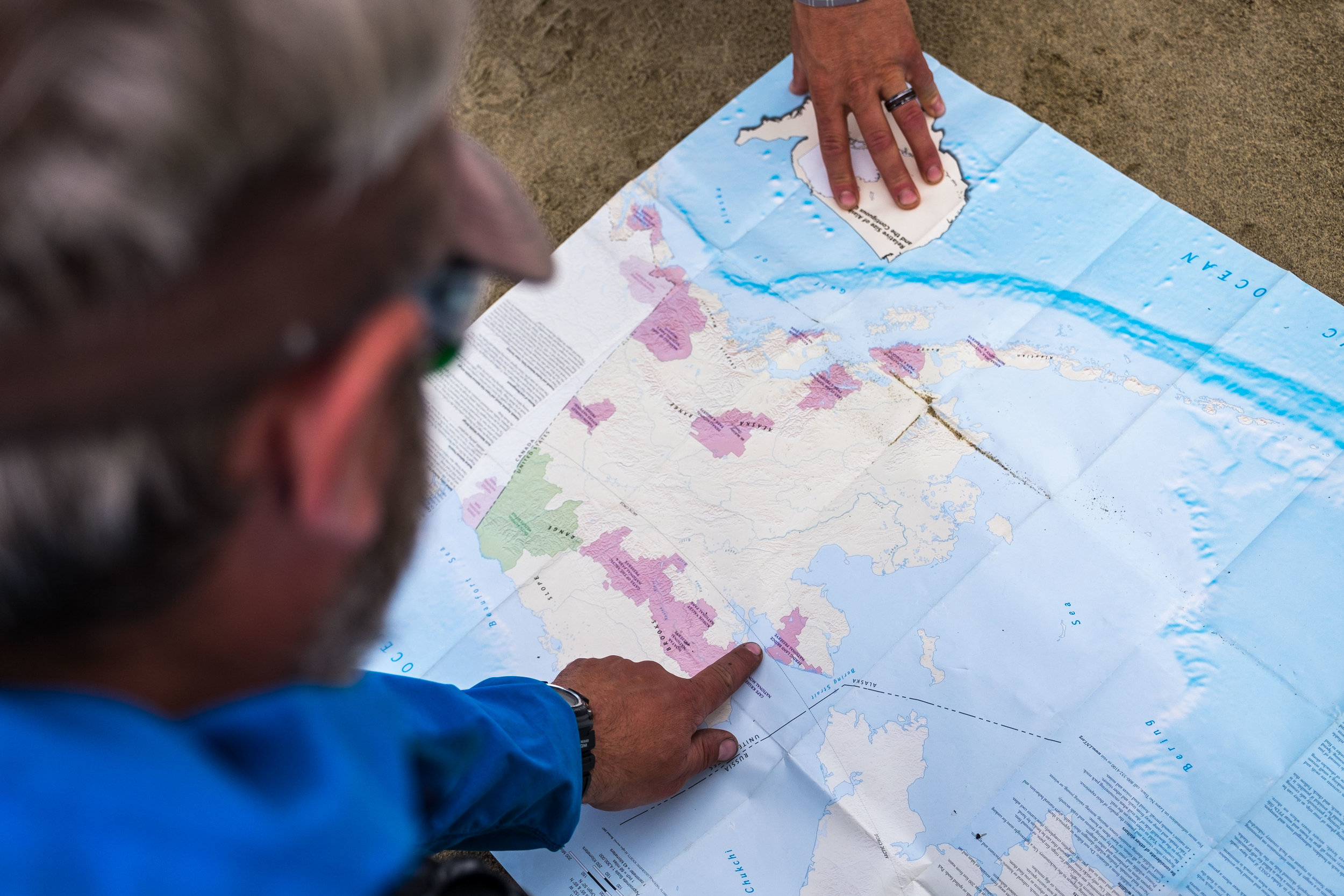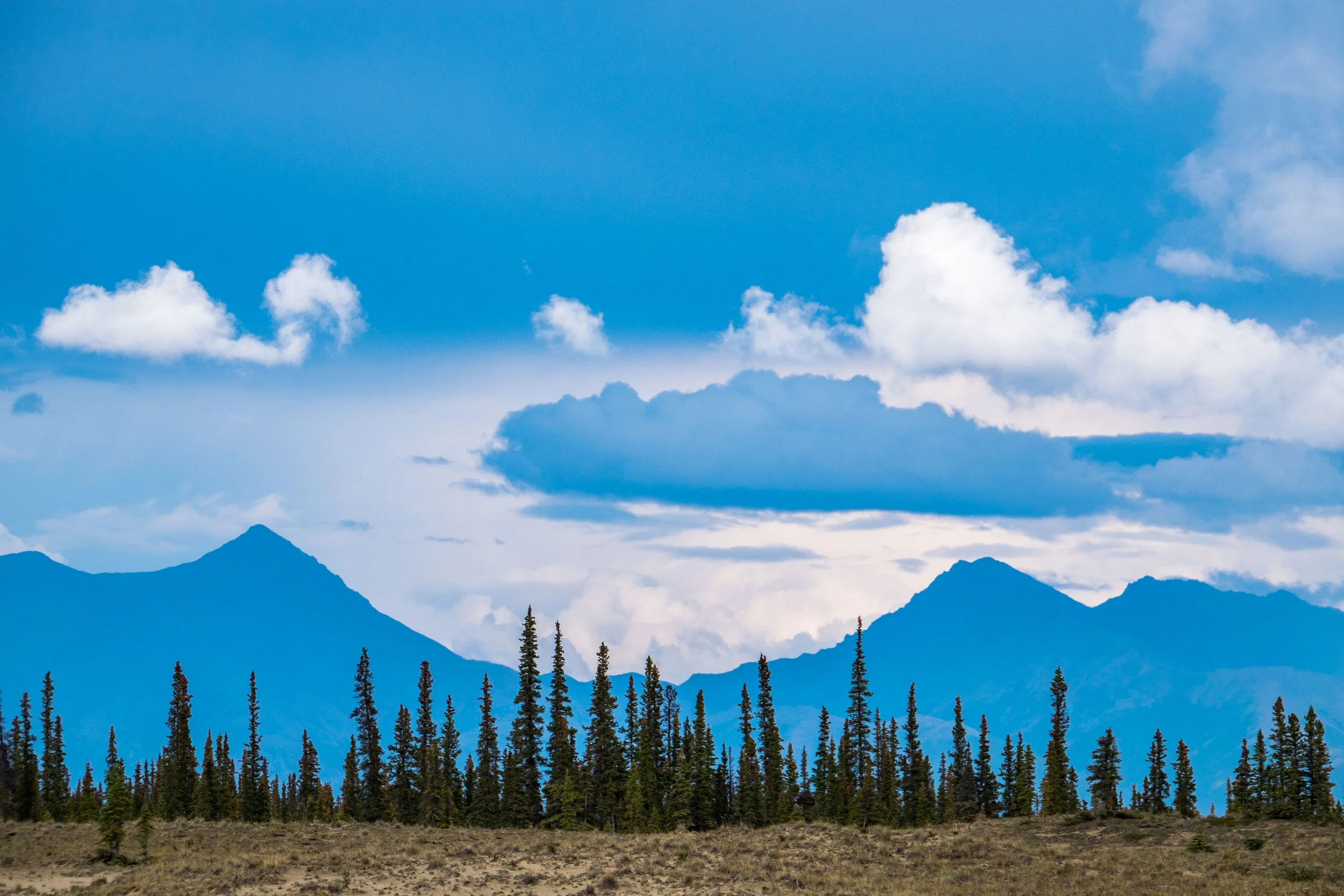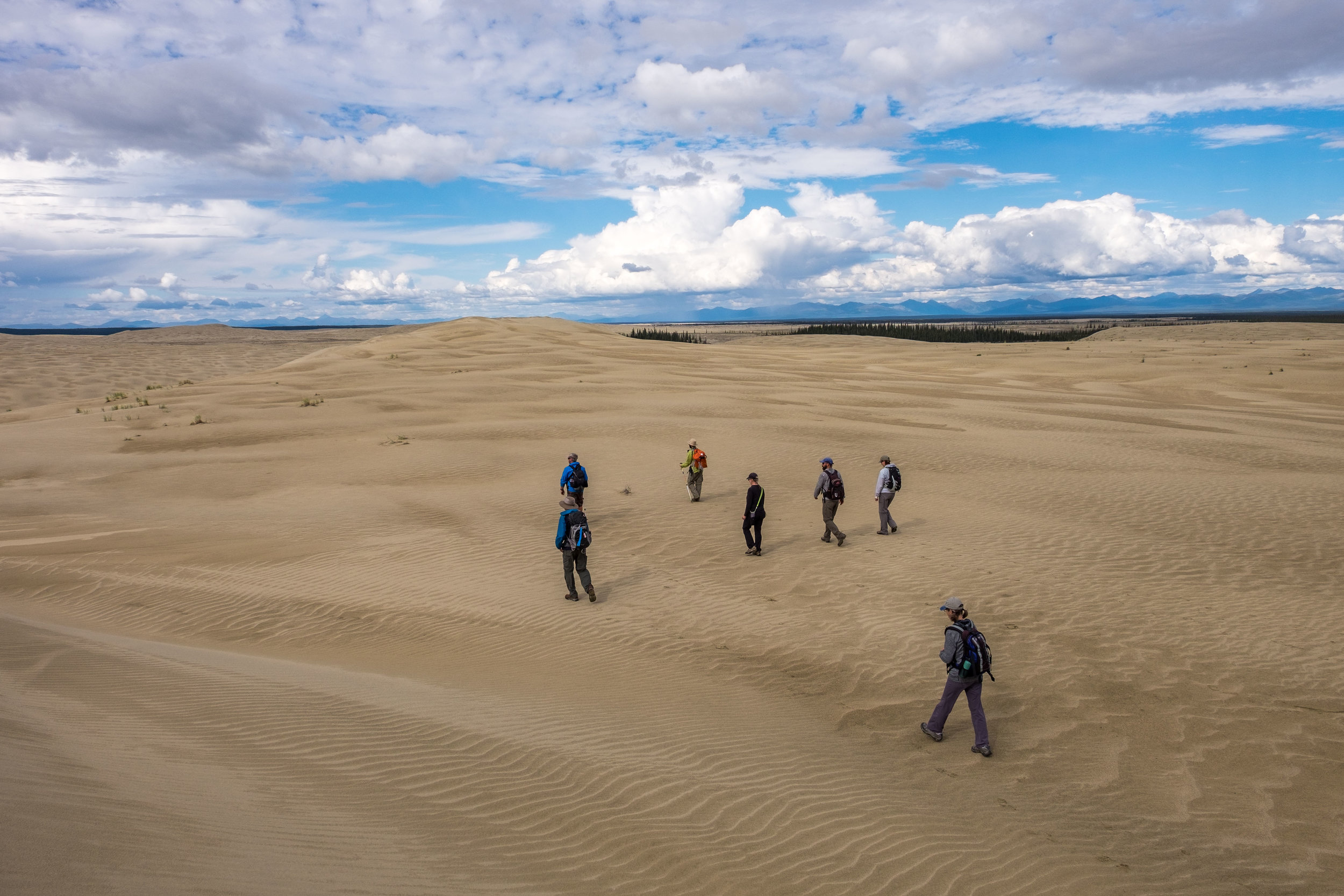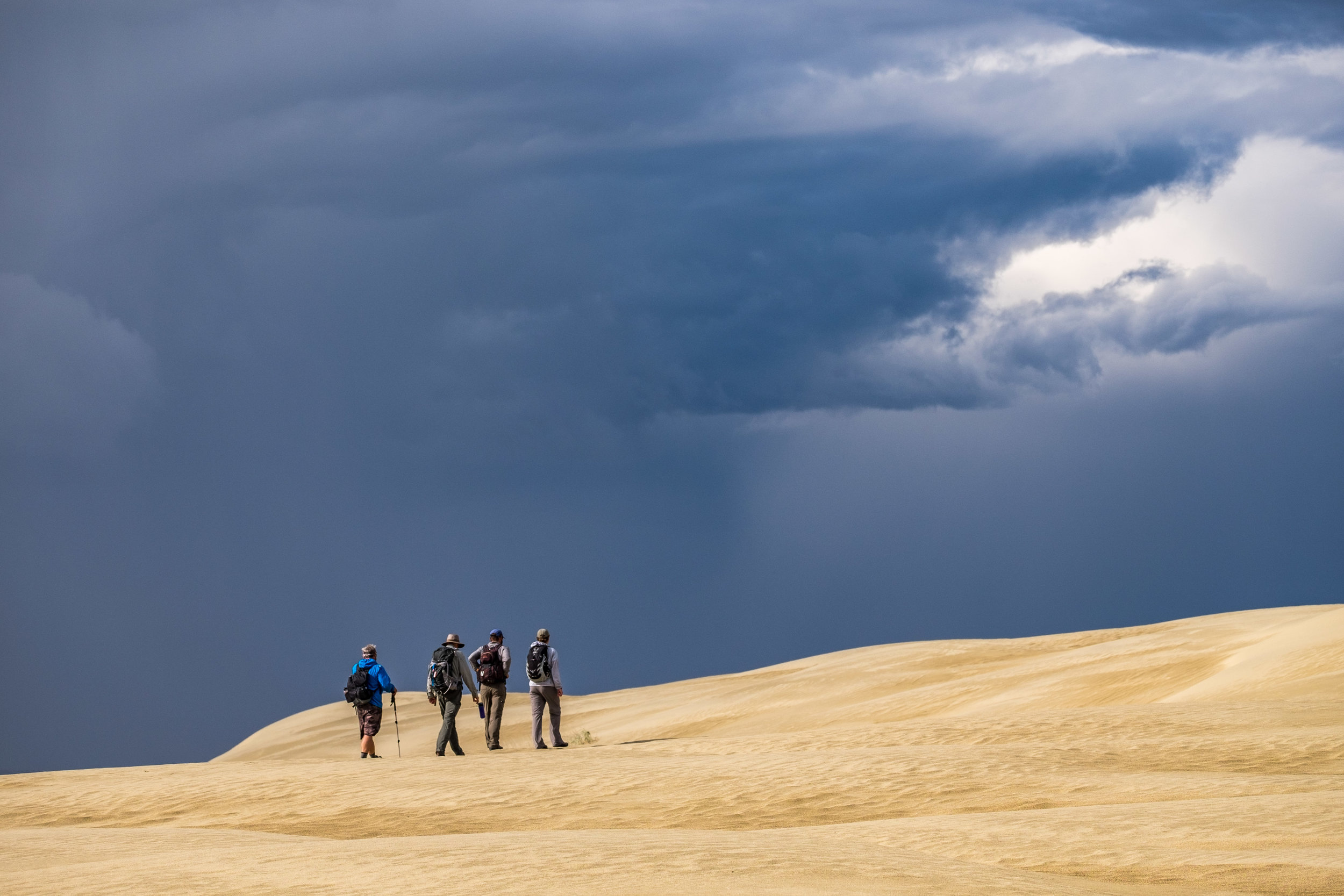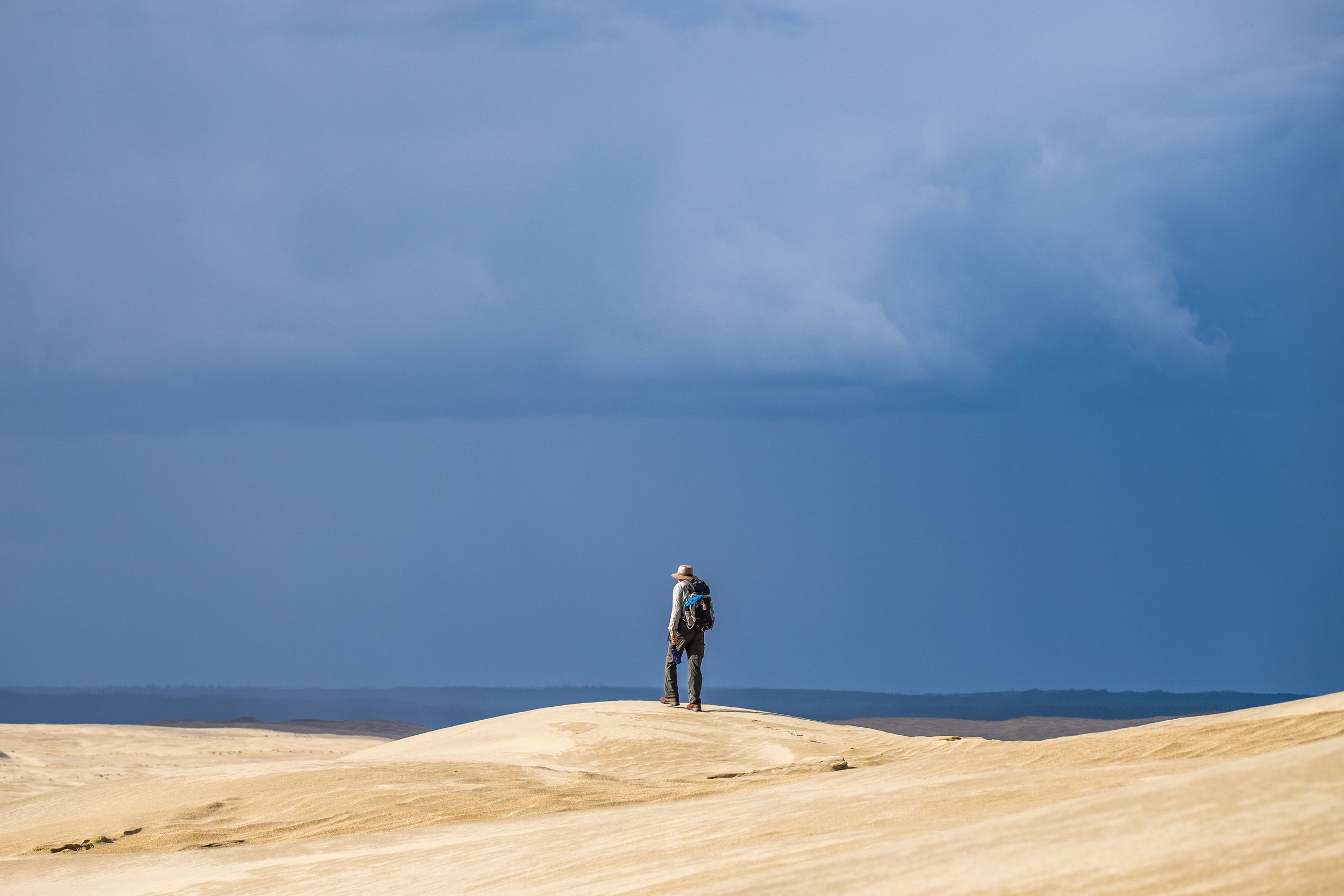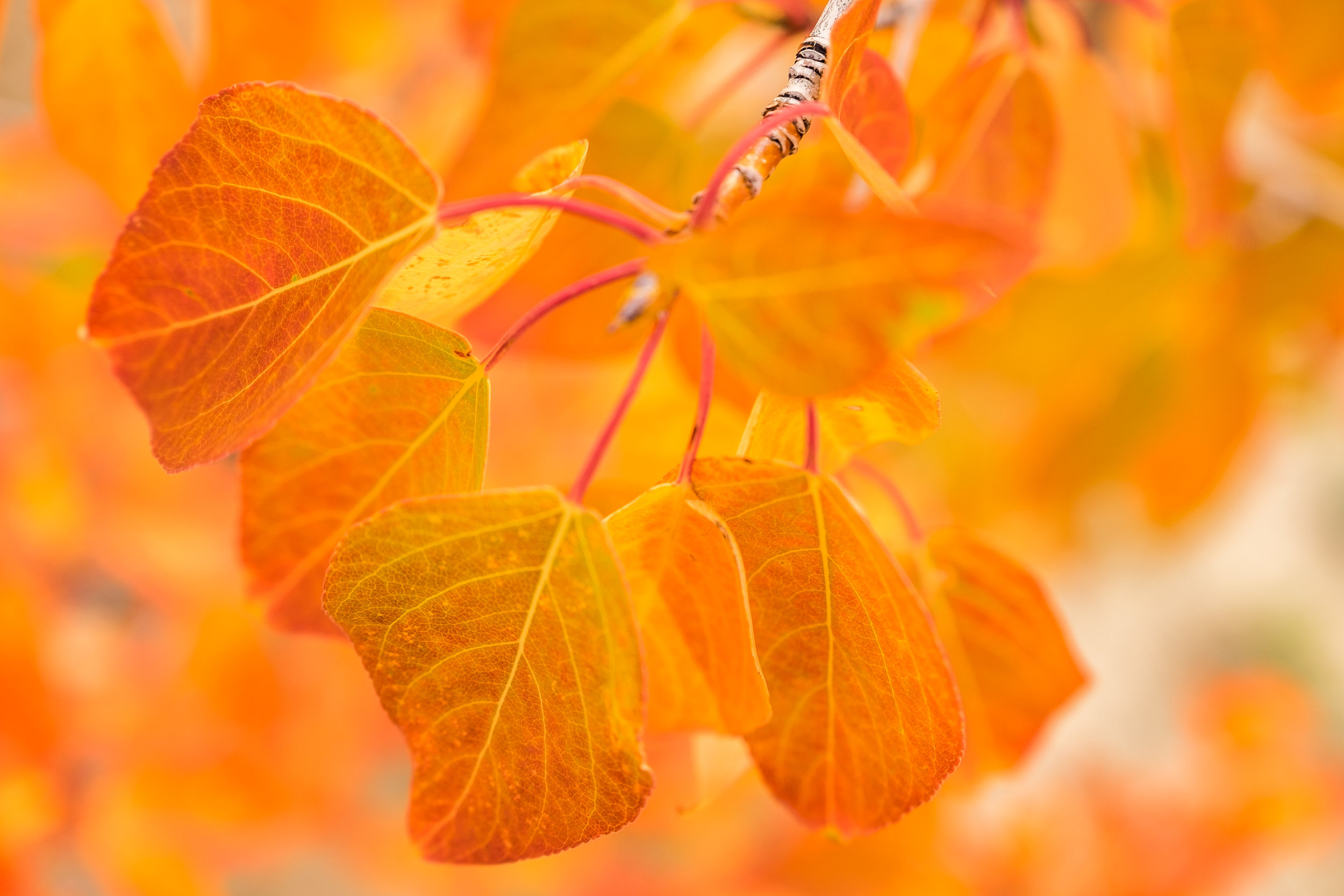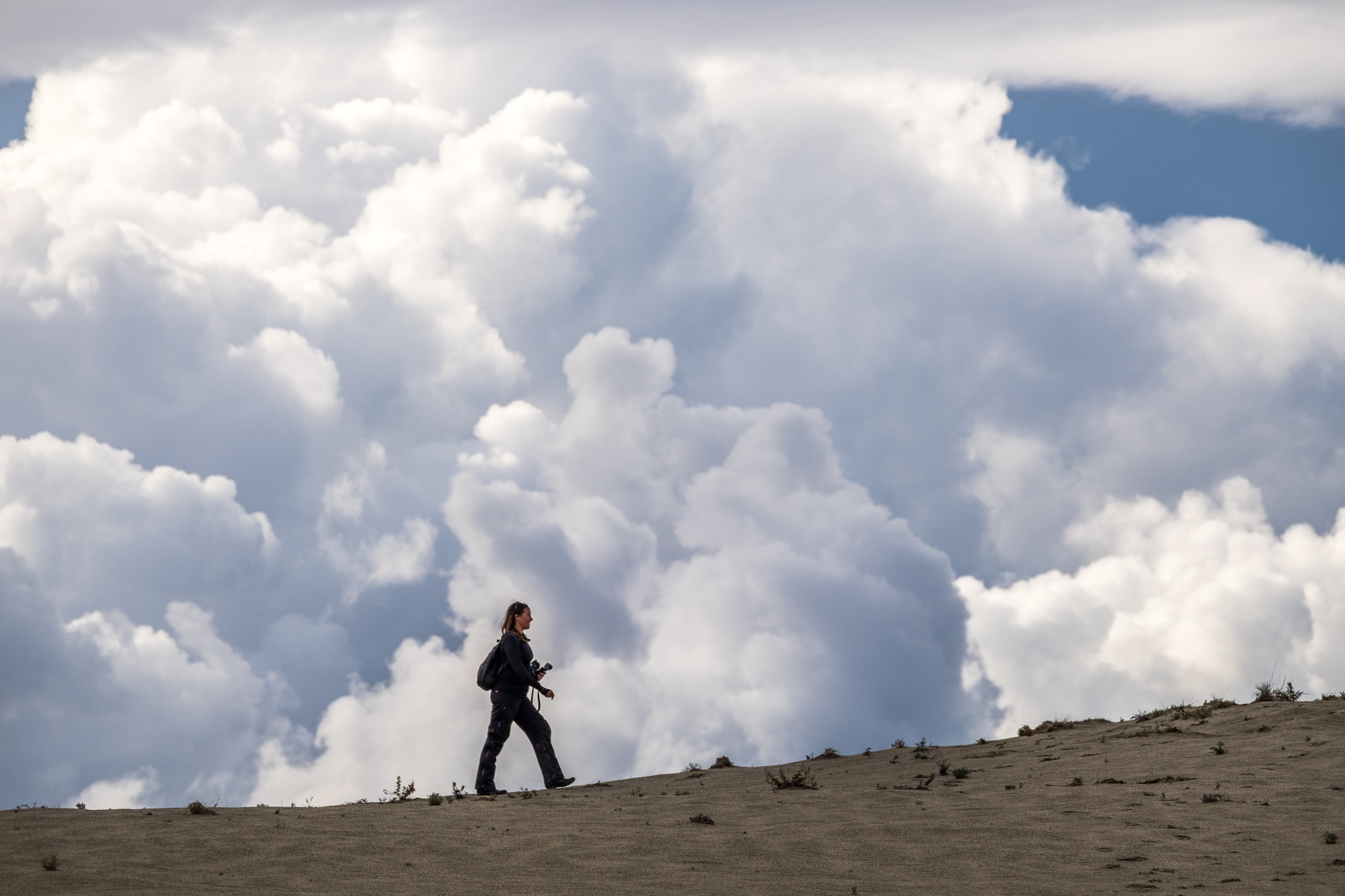Kobuk Valley National Park, Alaska, USA | Park 36/59
“Now we were alone between fringes of spruce by a clear stream where tundra went up the sides of mountains... it was, in all likelihood, the most isolated wilderness I would ever see.”
6 Wonders in Kobuk Valley: America's Least Visited National Park
The enchanting, like-a-dream landscape at Kobuk National Park in Alaska.
In the great state of Alaska, north of the Arctic Circle, there is a place where you can be dropped off by bush plane and stand amidst one of Earth's last true wilderness places. There are no signs of humanity in your perimeter; there is nothing other than wide open space stretching far into the distance. There are no man-made trails, only game trails, winding through spruce and birch forests that hug the foothills of the mountains and serve as a habitat for wildlife. Beneath your feet is soft Arctic sand decorated by grizzly bear tracks; the dunes, a relic of the last Ice Age. Catching your eye on the horizon is the Kobuk River, softly glinting whenever sunlight lands upon it. It is without measure one of the most pristine areas on the planet; it is Kobuk Valley, America's least visited national park.
Because Kobuk is so completely unique and because it is realistically a place that few travelers will ever journey to, we wanted to paint a picture of it by breaking down what we think are some of the most notable features in the area—so you can virtually travel there right here. We've also included some info on how to go about getting there and some simple safety measures if you are adding Kobuk to your real-life travel itinerary. Onward!
Arctic Sand Dunes: There are a few national parks in America where sand dunes can be found: Guadalupe Mountains in Texas; Death Valley in California/Nevada; Great Sand Dunes in Colorado, and probably others that we’ve seen but are failing to mention here. Kobuk Valley is the only park where you can find Arctic sand dunes that, as the National Park Service puts it, “look more at home in the Sahara than 35 miles above the Arctic Circle."
The dunes were formed over tens of thousands of years with the rise and retreat of glaciers in the high mountains that surround the Kobuk Valley. Over such a long stretch of time, the activity forced the rocks into fine grains of sand that layered itself into large piles around the bases of the mountains forming the dunes we see today. It is an environment that is full of life with sprouting grasses, wildflowers, sedges, and wild rye rising from the sands; with scatterings of geological remnants including schist and jade (which there are large deposits of in the east area of the park.)
There are three dune fields in the park: the Great Kobuk Sand Dunes, Little Kobuk Sand Dunes, and the Hunt River Dunes. The Great Kobuk Dunes in the eastern area of the park are the most accessible, rising 100-feet high from the ground and stretching 25-square miles, rolling in beautiful formations across the landscape—its a marvelous place to hike, play, and photograph. If you can arrange it, your bush pilot can let you off right on top of them, and the in-flight is mesmerizing.
The most active Arctic sand dunes on the planet can be found at Kobuk Valley National Park in Alaska.
Wind blows the grasses in circles atop the dunes. So cool!
Even if you don't see the caribou migration or any wildlife at all, their presence is represented throughout the park. Here, a caribou antler in black and white.
Caribou migration: Kobuk Valley National Park is home to the largest herd of wildlife in Alaska. Holding at a population of around half a million strong, the nomadic Western Arctic Caribou travels through the park during migration each fall from their northern calving grounds to their southern wintering areas. In late September, you can see their hoof prints stretching across the dunes; year round from a bush plane, you can see their trails tracking through the tundra that have created a permanent effect of erosion from the trampling of vegetation. You maybe never see them, but their presence is always represented... caribou have sustained native Inupiat people in the area for millennia.
Wildlife: Wildlife is ever-present in the park even if you never see one species. Even the birds are elusive, darting between trees faster than you can raise your binocs. Animal tracks stretch across the dunes. Games trails of all sizes traverse the landscape providing passageways for black and grizzly bears, wolves, moose, porcupines, and foxes to travel to and fro. Raptors fly overhead and salmon swim in the Kobuk River. Fauna is everywhere, just quiet yourself and let the wilderness open up to you.
Native Alaskan history: Kobuk may be the least touristed national park, but in the areas surrounding the Kobuk River live hundreds of native Inupiat people in small villages who still conduct a subsistence lifestyle the way their ancestors have for 10,000 years. In the extreme conditions, they get around on snow mobiles (which in Alaska they call “snow-machines”) and rely on hunting (bear and caribou) and fishing (salmon) to sustain their communities. The Kobuk National Park management plan aims to protect traditional native practices of subsistence living ahead of tourism opportunities, and as such, no facilities or trails lie within the park boundaries leaving us a remarkably uncluttered place to explore.
One-of-a-kind scenery: To stand atop the Great Kobuk Sand Dunes and spin a 360, you would have no idea where you were—sand dunes, tundra, forest, rivers, mountains, and big sky don't generally sit altogether in one place. The confluence is in a transition zone between boreal forest and treeless Arctic tundra, giving way to densely blanketed tundra leading off into the Waring and Baird mountains. In the forests you will find organisms such as algae, fungi, mosses, and lichen. The Salmon River, like the Noatak River in Gates of the Arctic, has a wild designation given by the National Wild and Scenic River System; and a 60-mile stretch of the Kobuk River also runs through the park. And rising amidst it all are immaculate dunes... in the Arctic north—it's totally surreal. Kobuk has a sense of place that makes you feel a little bit as though you are wandering inside of a landscape painting or in a storybook tale, and you can get there from Anchorage or Fairbanks in just a few hours.
A horseshoe bend formed by the Kobuk River separating the Arctic sand dunes and the tundra landscape.
Fall foliage sprouts from the forest floor.
We found the Super Mario Brothers mushroom in the magical forest!
Dunes, forest, mountains, and big sky -- the wonderful wilderness of Kobuk is incredibly diverse.
Extreme solitude: Touching down atop the Arctic dunes in Kobuk was the first time in recent memory that any of us could recall being completely alone outside, without the possibility of someone other than a moose, a bear, a wolf, or a bird, watching us. When you are alone in that way, it is a very strange feeling... it’s absolutely wonderful. Depending on how and when you travel in Kobuk, you might come across native Inupiat peoples from nearby villages hunting or fishing in the park—particularly so during the annual autumn caribou migration—but such a run-in is unlikely in a wilderness that is so vast. It is highly unlikely that you will see other travelers either, though you may see a bush plane fly overhead from time to time. Looking to really get away from it all? This is the place.
Our bush plane with tundra tires takes off, leaving us with the solitude of Kobuk Valley National Park in Alaska.
Left with our gear in the Arctic Alaskan wilderness... we got creative right away.
How to explore the park: Kobuk is the least visited park for a reason—it’s a challenge to both get to and to navigate, and it would be ill-advised to do so without hands-on guidance from those who know the region, climate, and way of life in Alaska. Such assistance doesn’t come cheap, either. Alaska is notoriously expensive, and getting to Kobuk is particularly so as there are only a few outfits that know the area and operate there.
Here's a breakdown of ways to explore Kobuk:
- Some visitors mark this one off of their national park bucket list by scheduling a bush flight from the nearby access point of Bettles for a visual tour of the park, while setting foot down only for an afternoon stroll and a picnic on the dunes. This flightseeing experience is the easiest way to get "into" Kobuk.
- Those up for a bigger challenge arrange their own bush flights and go backpacking inside of the park.
- There are several lodges scattered around the Kobuk wilderness that provide access and guidance.
- For those (like us) wanting to see as much as the park as possible in a short amount of time, there are a select number of guided adventures that provide immersive experiences. Ours was with Alaska Alpine Adventures, the leading adventure travel operator in many of the wildest places in Alaska. (Below are some photos of our traveling posse doing what people do in the wild...)
Getting there: Commercial flights run daily from Anchorage to Kotzebue, where the park’s information center is located and from where you will jump off from to get into Kobuk. Kotzebue is the nearest full service town (a fishing village with a population of approximately 3,000) to the park. The National Park Service provides a resource guide to air taxi companies operating in the area on the official park website.
A note about safety and smart travel: Like Gates of the Arctic, Kobuk is so remote that help is days away if you need it and as such, you should either travel with a guide outfit or have rock solid survival skills. Either way, you must have a plan. Even armed with outdoor skills—lack of communication, a very remote location, and unpredictable weather can leave travelers stranded for days. Planning for that kind of situation is vital. It is also important if on your own to keep with you a compass and topographic map as the dunes are a disorienting place to wander and it is easy to lose your way. And don't forget a filter/iodine pills to treat your water. Leave an itinerary with loved ones... Those are just a few of the precautions to take entering the Kobuk wilderness. As always in all of our national parks, your safety is your own responsibility and yours alone.
There are no hiking stick medallions from Kobuk, but their are other ways to be creative! Signing off in the Arctic dunes.
Quotable Images
Fact Box
1.75 acres | America's least visited national park | Home to rare Arctic sand dunes
Official name: Kobuk Valley National Park
Kobuk National Park in Arctic Alaska.
Established: December 2, 1980
Location: Northern interior Alaska in the central Brooks Range. The nearest major town with air services is in Kotzebue, located 100 miles away.
How the park got its name: According to the National Park Service, Kobuk Valley National Park is named after the river that runs through it: the Kobuk River. "Kobuk" translates as "big river" in native Inupiat.
How to get there: Fly in from Kotzebue or from a prearranged remote pick-up location, either by float plane landing on the Kobuk River (a 60-mile segment of runs through the park); or by bush plane outfitted with tundra tires touching down right on the Arctic dunes.
Walking atop the Great Kobuk Sand Dunes in August, 2016.
Iconic site in the park: The phrase "Arctic sand dunes" doesn't even compute... it is a true oddity. But there they are in Kobuk, sprawled out onto the landscape in a region that feels nothing like one where you should find 100-feet high mountains of sand. The Great Kobuk Sand Dunes are the largest active dune fields in North America. Remnants of the Pleistocene era, they are surrounded today by spruce forest and treeless tundra—it is an atmosphere so unique that the National Aeronautics and Space Administration (NASA) has conducted analogue missions there to help prepare for future journeys to Mars... so it is safe to say that walking across the Great Kobuk Dunes is like walking on a different planet—and it sits just a couple of hours by plane from Fairbanks!
Accessible adventure: Kobuk is not a national park that most casual travelers seek out. It is really far out there. I am fairly certain that a large majority of visitors to the park are in the throes of a quest to see all of the U.S. National Parks, just like we are this year. If you are on the toe-dip route and don’t have a lot of time to spend digging in, there are a couple of small outfits operating out of the small town of Bettles that offer one-day flightseeing trips to the park where you can touch down atop of the dunes for a picnic lunch. If you have just a small amount of time to see one of the most remote parks in the system, this is a great way to do it.
All set up to camp out in the Kobuk wilderness!
Big adventure: The only way to spend a night in Kobuk National Park is to go camping in backcountry! With no established roads, trails, and campgrounds in the park, this is your passage to total solitude and a completely one-of-a-kind wilderness experience. You can either head into the bush on your own, or with a small group on a guided trip. We traveled with Alaskan Alpine Adventures in conjunction with a 5-day float trip down the Noatak River in Gates of the Arctic. As the two parks are nearby neighbors, logistically, this made sense in terms of our needs. If you choose to go out on your own, check in at the Northwest Arctic Heritage Center in the nearby town of Kotzebue first to discuss and plan your itinerary and brief out on safety precautions.
There are only a few ways into the park: by bushplane, on snow mobile's or on foot. We flew in from Gates of the Arctic.
Did you know…
Kobuk Valley National Park is America's least visited national park.
Because of its truly remote landscape, the National Park Service doesn’t staff rangers in the park, and without entrance gate monitoring and staff, tracking visitation isn't really viable. The last visitor count recorded by the Park Service was 16,875 souls in 2014.
The only ways to get into the Kobuk Valley National Park are by bush plane, boat, dogsled, snow machine, or on foot. There is no entrance fee to enter the park.
Kobuk is located entirely north of the Arctic Circle, 32 miles west of Gates of the Arctic National Park and Preserve. These are the only two U.S. National Parks located north of the Arctic Circle.
Despite its far northern global position, the area can be blazing hot during the summer—reaching more than 100 degrees Fahrenheit.
The 30-square miles of sand dunes at Kobuk are the largest active dune fields located in Arctic latitudes.
Jade can be found on the dunes. It has a deep slate color in its natural form that gives way to vibrant green when cut and polished. But as is true in all of our national parks, removing anything from the natural landscape is forbidden!
The Onion Portage Archeological District on the north bank of the Kobuk River is where a major caribou crossing occurs each year around Labor Day—with hundreds upon hundreds of thousands of caribou, it is the largest crossing of its kind in North America.
For nearly 10,000 years, natives have hunted caribou during their annual migration for food and supplies.
Kobuk Valley is not just a national park, but home to native subsistence communities who are—unlike visitors—allowed to hunt, fish and gather on national parkland. Preservation of subsistence communities is prevalent throughout Alaska. If you see private land and property while exploring in the Alaskan bush, please respect their property and belongings and do your best to steer clear.
Kobuk is an ancient wilderness.
Hiking and camping are two of the most popular ways to experience the park.
Pitching a tent is allowed anywhere (except for on native holdings).
Weather is unpredictable and can leave travelers stranded for days! Bring with you your patience (and maybe a good book.)
Grayling Stream by Constance Baltuck, Acrylic on canvas, 2011 Kobuk Valley National Park Artist-in-Residence. Credit: NPS
Like many of the national parks, Kobuk Valley offers an Artist-in-Residence program, inviting creatives into the park for an extended period of time to make beautiful things while helping to share the beauty of America’s wilderness places. Within a year of their time, they are asked to donate one piece of art representative of their time spent there to be out on display at the Northwest Arctic Heritage Center in Kotzebue. Click here to apply for an Artist-in-Residence slot in Kobuk.
In our Gates of the Arctic article we talked about gearing up but we failed to mention “sacred socks!” Sacred socks are regular wool socks stuffed into the bottom of your sleeping bag and left there during the entirety of your backcountry adventure. It is vital to always have one pair of dry socks, always. Thank you Alaska Alpine Adventures for this awesome backcountry camping hack!
There are no trails in Kobuk National Park save “game trails” – trails bushwacked by wildlife. Wildlife that is commonly found (though can be difficult to see) in Kobuk include moose, wolf, grizzly and black bears, and caribou.
Jonathan looking fashionable in his mosquito resistant bee-keeping outfit. :)
The good news: there are no poisonous or venomous spiders or snakes living in the region. The bad news: Mosquitos and gnats are monsters and ever-present during June and July. Bring your bug gear!
Strict leave-no-trace efforts are consistently achieved by visitors, and that effort is evident as you would never know that man has ever walked there—it is that pristine!
Most of Alaska’s National Parks are best visited during the North American summer months. In Kobuk in June and July, wildflowers bloom across the landscape. In early September, the famous caribou migration is in full effect.
Gates of the Arctic and Kobuk National Parks do not make hiking stick medallions. Darn!! You can find most other park swag with Alaska flavor at Alaska Geographic, Alaska’s official non-profit organization for the National Park Service.




